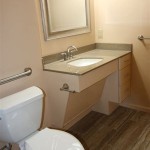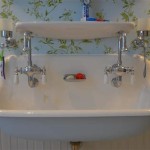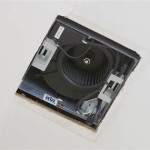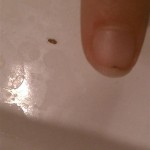How to Install a Bathroom Vanity Sink Top
Installing a bathroom vanity sink top is a common home improvement project that can significantly enhance the aesthetic appeal and functionality of a bathroom. While professional installation is an option, homeowners with moderate DIY skills can often complete the task successfully by carefully following a defined process. This article provides a detailed guide on how to install a bathroom vanity sink top, covering essential steps, tools, and considerations.
Before initiating the installation process, meticulous planning and preparation are crucial. This includes accurate measurements, selecting the appropriate materials, and ensuring all necessary tools are readily available. Failure to adequately prepare can lead to complications and delays.
The selection of a suitable vanity sink top involves considering factors such as material, style, size, and compatibility with the existing vanity cabinet. Common materials include ceramic, porcelain, granite, marble, quartz, and solid surface materials. Each material possesses unique characteristics regarding durability, aesthetics, and maintenance requirements.
The following tools and materials are typically required for installing a bathroom vanity sink top:
- New vanity sink top
- Measuring tape
- Level
- Pencil or marker
- Silicone caulk
- Caulk gun
- Adjustable wrench
- Plumber's putty
- Basin wrench (optional, for removing old plumbing)
- Safety glasses
- Gloves
- Clean rags or paper towels
- Shims (if needed for leveling)
Prior to beginning installation, the work area should be properly prepared. This involves clearing the surrounding space, protecting nearby surfaces with drop cloths, and ensuring adequate lighting. If replacing an existing sink top, the old unit must be removed carefully.
Removing the Existing Vanity Sink Top
The removal of the existing vanity sink top is a critical first step, and it must be performed carefully to avoid damaging the vanity cabinet or plumbing. The process generally involves the following steps:
- Shut Off the Water Supply: Locate the shut-off valves beneath the sink and turn them clockwise to completely cut off the water supply to the faucet. If shut-off valves are not present, the main water supply to the house must be shut off.
- Disconnect the Plumbing: Using an adjustable wrench, carefully disconnect the water supply lines (hot and cold) from the faucet tailpieces. Place a bucket beneath the connections to catch any residual water. Next, disconnect the drainpipe from the tailpiece of the sink drain. A basin wrench may be necessary for loosening tight connections in hard-to-reach areas.
- Detach the Sink from the Vanity: Depending on the type of sink top, it may be secured to the vanity cabinet with clips, screws, or adhesive. Inspect the underside of the sink top for any visible fasteners and remove them. If the sink is adhered to the cabinet, use a utility knife to carefully score along the seam between the sink top and the cabinet to break the adhesive bond.
- Lift Out the Old Sink Top: With all connections and fasteners removed, carefully lift the old sink top from the vanity cabinet. It may be necessary to gently pry the sink top loose if it is still stuck. Enlist assistance if the sink top is heavy or awkward to handle.
- Clean the Vanity Cabinet: After removing the old sink top, thoroughly clean the top of the vanity cabinet to remove any debris, adhesive residue, or old caulk. A scraper or putty knife can be used to remove stubborn residue. Ensure the surface is clean and dry before proceeding.
Following the removal of the old sink top, a thorough inspection of the vanity cabinet is recommended to identify any potential issues that may need to be addressed before installing the new sink top. This includes checking for structural damage, such as warping or rot, and ensuring the cabinet is level and stable. Any necessary repairs or adjustments should be carried out before proceeding.
Preparing and Installing the New Vanity Sink Top
Once the old sink top has been removed and the vanity cabinet has been prepared, the installation of the new sink top can begin. This process involves careful alignment, securing the sink top to the cabinet, and applying caulk to create a watertight seal.
- Dry Fit the New Sink Top: Carefully place the new sink top onto the vanity cabinet, ensuring it is properly aligned and centered. Check the fit and alignment from all angles. If the vanity cabinet is not perfectly level, use shims to level the sink top. Place shims under the sink top where necessary to achieve a level surface.
- Mark the Faucet and Drain Locations: With the sink top properly positioned, use a pencil or marker to mark the locations of the faucet holes and drain opening on the vanity cabinet. This will help ensure accurate alignment during the plumbing installation phase.
- Apply Silicone Caulk: Apply a bead of silicone caulk along the top edge of the vanity cabinet where the sink top will make contact. The caulk will provide a watertight seal and help secure the sink top to the cabinet. Use a high-quality, mold-resistant silicone caulk formulated for bathroom applications.
- Secure the Sink Top: Carefully lower the sink top onto the vanity cabinet, aligning it with the marked locations and pressing it firmly onto the caulk. If the sink top is designed to be secured with clips or screws, install them according to the manufacturer's instructions. Ensure the sink top is level and stable.
- Clean Excess Caulk: Use a damp rag or paper towel to wipe away any excess caulk that squeezes out from under the sink top. Smooth the caulk bead with a finger or a caulk smoothing tool to create a neat and professional finish.
- Allow Caulk to Cure: Allow the caulk to cure completely according to the manufacturer's instructions. This typically takes 24 to 48 hours. Avoid using the sink during this period to ensure the caulk sets properly.
After the caulk has cured, the plumbing connections can be reestablished. This involves reinstalling the faucet, drain, and water supply lines.
Connecting the Plumbing
Connecting the plumbing accurately and securely is essential for preventing leaks and ensuring the proper functioning of the sink. This process involves reinstalling the faucet, drain, and water supply lines, adhering to best practices for plumbing connections.
- Install the Faucet: Install the faucet according to the manufacturer's instructions. This typically involves inserting the faucet shanks through the holes in the sink top and securing them with mounting hardware from below. Connect the water supply lines to the faucet tailpieces, ensuring the connections are tight and leak-free.
- Install the Drain: Install the drain assembly, including the drain flange, stopper, and tailpiece. Apply plumber's putty to the underside of the drain flange before inserting it into the drain opening in the sink top. Tighten the drain flange nut from below to create a watertight seal. Connect the tailpiece to the drainpipe, using appropriate fittings and ensuring the connections are tight and leak-free.
- Connect the Water Supply Lines: Reconnect the water supply lines to the faucet tailpieces, ensuring the connections are tight and leak-free. Use new Teflon tape on the threads of the fittings to enhance the seal.
- Check for Leaks: Turn on the water supply slowly and carefully check all connections for leaks. If any leaks are detected, tighten the connections or replace the fittings as necessary.
Once the plumbing connections have been completed and verified to be leak-free, the final steps involve cleaning the sink and surrounding area, and testing the functionality of the faucet and drain.
After completing the installation, thoroughly clean the sink top and surrounding area to remove any dirt, debris, or fingerprints. Test the faucet to ensure it is functioning properly and that both hot and cold water are flowing correctly. Test the drain to ensure it is draining freely and that the stopper is operating smoothly. If any issues are encountered, troubleshoot and address them promptly.
Proper ventilation is also important to consider. Ensure there’s adequate ventilation in the bathroom to prevent moisture buildup, which can lead to mold and mildew growth around the sink and vanity.
Adhering to local plumbing codes is essential. Ensure the installation complies with all applicable local plumbing codes and regulations. If unsure, consult with a licensed plumber to ensure compliance.
By following these steps carefully and paying attention to detail, homeowners can successfully install a bathroom vanity sink top and enhance the functionality and aesthetics of their bathroom. Remember to prioritize safety and take necessary precautions throughout the entire process.

Replace Vanity Top And Faucet Diy Network

How To Remove Replace A Vanity Top Easy Bathroom Sink Remodel

How To Install A Bathroom Vanity

How To Install A Vanity Top For Your Bathroom

12 Easy Steps To Install Bathroom Vanity And Sink

How To Install A Vanity Top Onyx Sink

How To Install Or Remove A Bathroom Vanity Homeserve Usa



Replace Vanity Top And Faucet Diy Network
Related Posts







